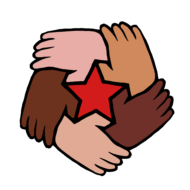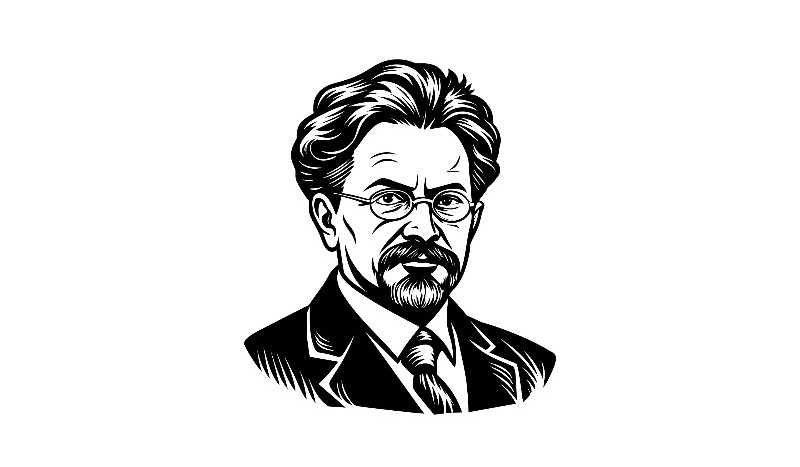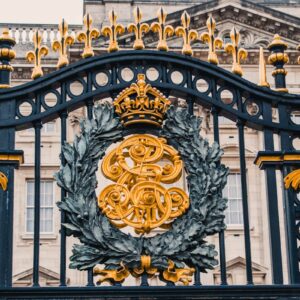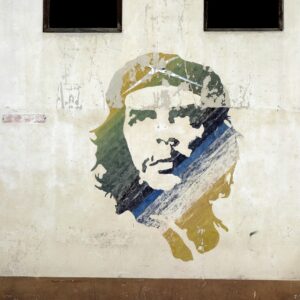by Harry Haywood, 1978, source: Marxist Internet Archive
Apart from our academic courses, we received our first tutelage in Leninism and the history of the Communist Party of the Soviet Union in the heat of the inner-party struggle then raging between Trotsky and the majority of the Central Committee led by Stalin. We KUTVA students were not simply bystanders, but were active participants in the struggle. Most students — and all of our group from the U.S. — were ardent supporters of Stalin and the Central Committee majority.
It had not always been thus. Otto told me that in 1924, a year before he arrived, a majority of the students in the school had been supporters of Trotsky. Trotsky was making a play for the Party youth, in opposition to the older Bolshevik stalwarts. With his usual demagogy, he claimed that the old leadership was betraying the revolution and had embarked on a course of “Thermidorian reaction.”1 In this situation, he said, the students and youth were “the Party’s truest barometer.”2
But by the time the Black American students arrived, the temporary attraction to Trotsky had been reversed. The issues involved in the struggle with Trotsky were discussed in the school. They involved the destiny of socialism in the Soviet Union. Which way were the Soviet people to go? What was to be the direction of their economic development? Was it possible to build a socialist economic system? These questions were not only theoretical ones, but were issues of life and death. The economic life of the country would not stand still and wait while they were being debated.
The Soviet working class, under the leadership of Lenin and the Bolsheviks, had vanquished capitalism over one-sixth of the globe; shattered its economic power; expropriated the capitalists and landlords; converted the factories, railroads and banks into public property; and was beginning to build a state-owned socialist industry. The Soviet government had begun to apply Lenin’s cooperative plans in agriculture and begun to fully develop a socialist economic system. This colossal task had to be undertaken by workers in alliance with the masses of working peasantry.
From the October Revolution through 1921, the economic system was characterized by War Communism. Basic industry was nationalized, and all questions were subordinated to the one of meeting the military needs engendered by the civil war and the the intervention of the capitalist countries.
But by 1921, the foreign powers who had attempted to overthrow the Soviets had largely been driven from Russia’s borders. It was then necessary to orient the economy toward a peace-time situation. The NEP (New Economic Policy) formulated at the Tenth Party Congress in 1921 was the policy designed to guide the transition from War Communism to the building of socialism. It replaced a system of surplus appropriation with a tax in kind which would be less of a burden on the peasantry. The NEP was a temporary retreat from socialist forms: smaller industries were leased to private capital to run; peasants were allowed to sell their agricultural surplus on free markets; central control over much of the economy was lessened. All of this was necessary to have the economy function on a peace-time basis. It was a measure designed to restore exchange of commodities between city and country which had been so greatly disrupted by the civil war and intervention.3 It was a temporary retreat from the attack on all remnants of capitalism, a time for the socialist state to stabilize its base area, to gather strength for another advance. A year later at the Eleventh Party Congress, Lenin declared that the retreat was ended and called on the Party to “prepare for an offensive on private capital.”4
Lenin was incapacitated by a series of strokes in 1923 and could no longer participate in the active leadership of the Party. It was precisely at this time, taking advantage of Lenin’s absence, that Trotsky made his bid for leadership in the Party. Trotsky had consistently opposed the NEP and its main engineer, Lenin — attacking the measures designed to appease the peasantry and maintain the coalition between the peasants and the workers.
From late 1922 on, Trotsky made a direct attack on the whole Leninist theory of revolution and the dictatorship of the proletariat. He denied the possibility (and necessity) of building socialism in one country, and instead characterized that theory as an abandonment of Marxist principles and a betrayal of the revolutionary movement. He postulated his own theory of “permanent revolution,” and contended that a genuine advance of socialism in the USSR would become possible only as a result of a socialist victory in the other industrially developed states.
While throwing around a good deal of left-sounding rhetoric, Trotsky’s theories were thoroughly defeatist and class-collaborationist. For instance, in the postscript to Program for Peace, written in 1922, he contended that “as long as the bourgeoisie remains in power in the other European countries, we shall be compelled, in our struggle against economic isolation, to strive for agreement with the capitalist world; at the same time it may be said with certainty that these agreements may at best help us to mitigate some of our economic ills, to take one or another step forward, but real progress of a socialist economy in Russia will become possible only after the victory of the proletariat in the major European countries.”5
At the base of this defeatism was Trotsky’s view that the peasantry would be hostile to socialism, since the proletariat would “have to make extremely deep inroads not only into feudal but also into bourgeois property relations.” Thus Trotsky contended that the working class would:
…come into hostile collision not only with all the bourgeois groupings which supported the proletariat during the first stages of its revolutionary struggle, but also with the broad masses of the peasantry with whose assistance it came into power. The contradictions in the position of a workers’ government in a backward country with an overwhelmingly peasant population could be solved only …in the arena of the world proletarian revolution.6
Therefore, it would not be possible to build socialism in a backwards, peasant country like Russia. The mass of peasants would exhaust their revolutionary potential even before the revolution had completed its bourgeois democratic tasks — the breakup of the feudal landed estates and the redistribution of the land among the peasantry. This line, which underestimated the role of the peasantry, had been put forward by Trotsky as early as 1915 in his article “The Struggle for Power.” There he claimed that imperialism was causing the revolutionary role of the peasantry to decline and downgraded the importance of the slogan “Confiscated the Landed Estates.”7
As it was pointed out in our classes, Trotsky portrayed the peasantry as an undifferentiated mass. He made no distinction between the masses of peasants who worked their own land (the muzhiks) and the exploiting strata who hired labor (the kulaks). His conclusions openly contradicted the strategy of the Bolsheviks, developed by Lenin, of building the worker-peasant alliance as the basis for the dictatorship of the proletariat.8Further, they were at complete variance with any realistic economic or social analysis.
Trotsky’s entire position reflected a lack of faith in the strength and resources of the Soviet people, the vast majority of whom were peasants. Since it denied the revolutionary potential of the peasantry, the success of the revolution could not come from internal forces, but had to depend on the success of proletarian revolutions in the advanced nations of Western Europe. In the absence of such revolutions, the revolutionary process within the Soviet Union itself would have to be held in abeyance, and the proletariat, which had seized power with the help of the peasantry, would have to hold state power in conflict with all other classes.
Behind Trotsky’s revolutionary rhetoric was a simplistic social-democratic view which regarded the class struggle for socialism as solely labor against capital. This concept of class struggle did not regard the struggle of peasant against landlord, or peasant against the Czar, as a constituent part of the struggle for socialism. This was reflected as early as 1905, in Trotsky’s slogan, “No Czar, but a Workers’ Government,” which, as Stalin had said, was “the slogan of revolution without the peasantry.”9
Given the state of the revolutionary forces at the time, the position was dangerously defeatist. For instance, 1923 marked a period of recession for the revolutionary wave in Europe; it was a year of defeat for communist movements in Germany, Italy, Poland and Bulgaria. What then, Stalin asked, is left for our revolution? Shall it “vegetate it its own contradictions and rot away while waiting for the world revolution?”10 To that question, Trotsky had no answer. Stalin’s reply was to build socialism in the Soviet Union. The Soviet working class, allied with the peasantry, had vanquished its own bourgeoisie politically and was fully capable of doing the job economically and building up a socialist society.
Stalin’s position did not mean the isolation of the Soviet Union. The danger of capitalist restoration still existed and would exist until the advent of a classless society. The Soviet people understood that they could not destroy this external danger by their own efforts, that it could only be finally destroyed as a result of a victorious revolution in at least several of the countries of the West. The triumph of socialism in the Soviet Union could not be final as long as the external danger existed. Therefore, the success of the revolutionary forces in the capitalist West was a vital concern of the Soviet people.
Trotsky’s scheme of permanent revolution downgraded not only the peasantry as a revolutionary force, but also the national liberation movements of oppressed peoples within the old Czarist Empire. Thus, in “The Struggle for Power,” he wrote that “imperialism does not contrapose the bourgeois nation to the old regime, but the proletariat to the bourgeois nation.”11
While Trotsky de-emphasized the national colonial question in the epoch of imperialism, Lenin, on the other hand, stressed its new importance. “Imperialism,” said Lenin, “means the progressively mounting oppression of the nations of the world by a handful of Great Powers; it means a period of wars between the latter to extend and consolidate the oppression of nations.”12
It was not until sometime later that I was able to fully grasp the implications of Trotsky’s concept of permanent revolution on the international scene. The most dramatic example was in Spain during the Spanish Civil War, 1936-39. The Trotskyist organization had infiltrated the anarchist movement in Catalonia and incited a revolt against the Loyalist government under the slogans of “Socialist Republic” and “Workers’ Government.” The Loyalist government, headed by Juan Negrin, a liberal Republican, was a coalition of all democratic parties. It included socialists, communists, liberal Republicans and anarchists – all in alliance against fascist counter-revolution led by Franco and backed by Hitler and Mussolini. The attempted coup against the Loyalist Government was typical of the Trotskyist attempts to short-circuit the bourgeois-democratic stage of the revolutionary process. The result was a “civil war within a civil war” and, had their strategy succeeded, it would have split the democratic coalition – effectively giving aid to the fascists.
In the United States I was to witness how Trotsky’s purist concept of class struggle led logically to the denial of the struggle for Black liberation as a special feature of the class struggle, revolutionary in its own right. As a result, the American Trotskyists found themselves isolated from that movement during the great upsurge of the thirties. But all this was to come later.13
At the time I was at KUTVA, Trotskyism had not yet emerged as an important tendency on the international scene. I did not foresee its future role as a disruptive force on the fringes of the international revolutionary movement. At that point, I wasn’t clear myself on a number of theoretical questions. It was somewhat later when my understanding of the national and colonial question — particularly the Afro-American question — deepened, that the implications of Trotsky’s theory of permanent revolution became fully obvious to me.
We students felt that Trotsky’s position denigrated the achievement of the Soviet Revolution. We didn’t like his continual harping about Russia’s backwardness and its inability to build socialism, or his theory of permanent revolution. The Soviet Union was an inspiration for all of us, a view confirmed by our experience in the country. Everything we could see defied Trotsky’s logic.
His writings were readily available throughout the school, and the issues of the struggle were constantly on the agenda in our collectives. These were discussed in our classes, as they were in factories, schools and peasant organizations throughout the country.
About once a month the collective would meet and a report would be given by Party representatives – sometimes local, sometimes from the rayon (region of the city) and Moscow district, and sometimes from the Central Committee itself. They would report on the latest developments in the inner-party struggles — Trotsky’s and Lenin’s views on the question of the peasantry; the NEP, how it had proved its usefulness and how it was now being phased out; Trotsky’s position on War Communism and Party rules; the dictatorship of the proletariat, and whether it could be a dictatorship in alliance with the peasantry or one over the peasantry. An open discussion would be held after the report. By that time the Trotskyists at KUTVA had dwindled to a small group of bitter-enders.
The struggle raged over a period of five years (1922-27) during which time the Trotsky bloc had access to the press and Trotsky’s works were widely circulated for everyone to read. Trotsky was not defeated by bureaucratic decisions or Stalin’s control of the Party apparatus — as his partisans and Trotskyite historians claim. He had his day in court and finally lost because his whole position flew in the face of Soviet and world realities. He was doomed to defeat because his ideas were incorrect and failed to conform to objective conditions, as well as the needs and interests of the Soviet people.
It was my great misfortune to be out of the dormitory when the Black students were invited to attend a session of the Seventh Plenum of the Executive Committee of the Communist International, then meeting in the Kremlin in the late fall of 1926. I was out in the street at the time and couldn’t be found, so they went without me. I missed a historic occasion, my only chance to have seen Trotsky in action. I was bitterly disappointed. When I arrived back at the dormitory, Sakorov, my Indian friend, told me where they had gone. Returning in the early hours of the morning, they found me waiting for them. They described the session and the stellar performance of Trotsky.
Stalin made the report for the Russian delegation. Trotsky then asked for two hours to defend his position; he was given one. He spoke in Russian, and then personally translated and delivered his speech in German and then in French. In all, he held the floor about three hours.
Otto said it was the greatest display of oratory he had ever heard. But despite this, Trotsky and his allies (Zinoviev and Kamenev) suffered a resounding defeat, obtaining only two votes out of the whole body. The delegates from outside the Soviet Union didn’t accept Trotsky’s view that socialism in one country was a betrayal of the revolution. On the contrary, the success of the Soviet Union in building socialism was an inspiration to the international revolution.
Otto told me that this point was made again and again and again in the course of the discussion. Ercoli (Togliatti), the young leader of the Italian Party, summed it up well a few days later when he defended the achievements of the Russian Party and revolution as “the strongest impetus for the revolutionary forces of the world.”14
The American Party united across factional lines in support of Stalin. The Trotsky opposition, already defeated within the Soviet Union, was now shattered internationally. From there on out, it was downhill for Trotsky. I witnessed Trotsky’s opposition bloc degenerate from an unprincipled faction within the Party to a counter-revolutionary conspiracy against the Party and the Soviet state. We learned of secret, illegal meetings held in the Silver Woods outside of Moscow, the establishment of factional printing presses — all in violation of Party discipline. Their activities reached a high point during the November 7, 1927 anniversary of the Revolution.
At the Tenth Anniversary, Trotsky’s followers attempted to stage a counter-demonstration in opposition to the traditional celebration. I remember vividly the scene of our school contingent marching its way to Red Square. As we passed the Hotel Moscow, Trotskyist leaflets were showered down on us, and orators appeared at the windows of the hotel shouting slogans of ‘Down with Stalin.’
They were answered with catcalls and booing from the crowds in the streets below. We seized the leaflets and tore them up. This attempt to rally the people against the Party was a total failure and struck no responsive chord among the masses. It was equivalent to rebellion and this demonstration was the last overt act of the Trotskyist opposition. During the next month Trotsky, Kamenev and Zinoviev were expelled — along with seventy-four of their chief supporters. They, along with the lesser fry, were sent into exile to Siberia in Central Asia. Trotsky was sent to Alma Alta in Turkestan from where, in 1929, he was allowed to go abroad, first to Turkey and eventually to Mexico.
Later, many of Trotsky’s followers criticized themselves and were accepted back into the Party. But among them was a hard core of bitter-enders, who “criticized” themselves publicly only in order to continue the struggle against Stalin’s leadership from within the Party. Their bitterness fed on itself and they emerged later in the thirties as part of a conspiracy which wound up on the side of Nazi Germany.
Throughout this whole struggle, we Black students at the school had been ardent supporters of the position of Stalin and the Central Committee. Most certainly we were Stalinists — whose policies we saw as the continuation of Lenin’s. Those today who use the term “Stalinist” as an epithet evade the real question: that is, were Stalin and the Central Committee correct? I believe history has proven that they were correct.
Notes
1. During the French Revolution, on July 27, 1794 (the ninth of Thermidor, according to the revolutionary calendar), a group later called the Thermidorians seized power, executing Robespierre, Saint-Just and more than eighty other radical Jacobins. This began a counter-revolutionary trend which led to Napoleon’s coup in 1799 and the restoration of several European monarchies in 1815.
2. Stalin, Works, vol. 5, p. 394.
3. History of the Communist Party of the Soviet Union (Bolsheviks) — Short Course (New York: International Publishers, 1939), p. 257. In this work, the Central Committee of the CPSU(B) sums up Lenin’s views on the NEP:
“A certain freedom of trade would give the peasant an economic incentive, induce him to produce more and would lead to a rapid improvement of agriculture…on this basis, the state-owned industries would be restored and private capital displaced…strength and resources having been accumulated, a powerful industry could be created as the economic foundation of Socialism, and then a determined offensive could be undertaken to destroy the remnants of capitalism in the country.”
4. Ibid., p. 257.
5. Quoted in Stalin, Works, vol. 6, p. 393.
6. Quoted in Stalin, Works, vol. 6, pp. 383-84.
7. V. I. Lenin, Collected Works (Moscow: Progress Publishers, 1964), vol. 21, pp. 418-19. It is here that Lenin shows, in opposition to Trotsky, that imperialism and especially war “strengthened the economic and political factors that are impelling the petty bourgeoisie, including the peasantry, to the left.”
8. Stalin, Works, vol. 6, p. 384. Stalin pointed out that “Lenin speaks of the alliance between the proletariat and the labouring strata of the peasantry as the basis of the dictatorship of the proletariat. Trotsky sees a ‘hostile collision’ between the ‘proletarian vanguard’ and the ‘broad masses of the peasantry.'”
9. Stalin, Works, vol. 6, p. 382.
10. Ibid., p. 385.
11.Lenin, Collected Works, vol. 21, p. 419.
12. Lenin, “The Revolutionary Proletariat and the Right of Nations to Self-Determination,” ibid., p. 409.
13. In the fifties and sixties, many communist parties dropped their revolutionary principles and launched vicious attacks on Stalin, opening the way for a temporary resurgence of Trotskyism. A new generation learned first-hand how Trotskyism uses revolutionary phrases to cover its attacks on every progressive movement, taking every opportunity to slander socialist China. They promoted slogans like “All Indochina Must Go Communist” as an excuse for their opposition to the popularly supported National Liberation Front of Vietnam. In current struggles in the Black liberation movement, they have liquidated the necessity for a revolutionary program of struggle, promoting instead reliance on the courts and other brands of reformism.
14. International Press Correspondence, January 12, 1927, p. 63.





